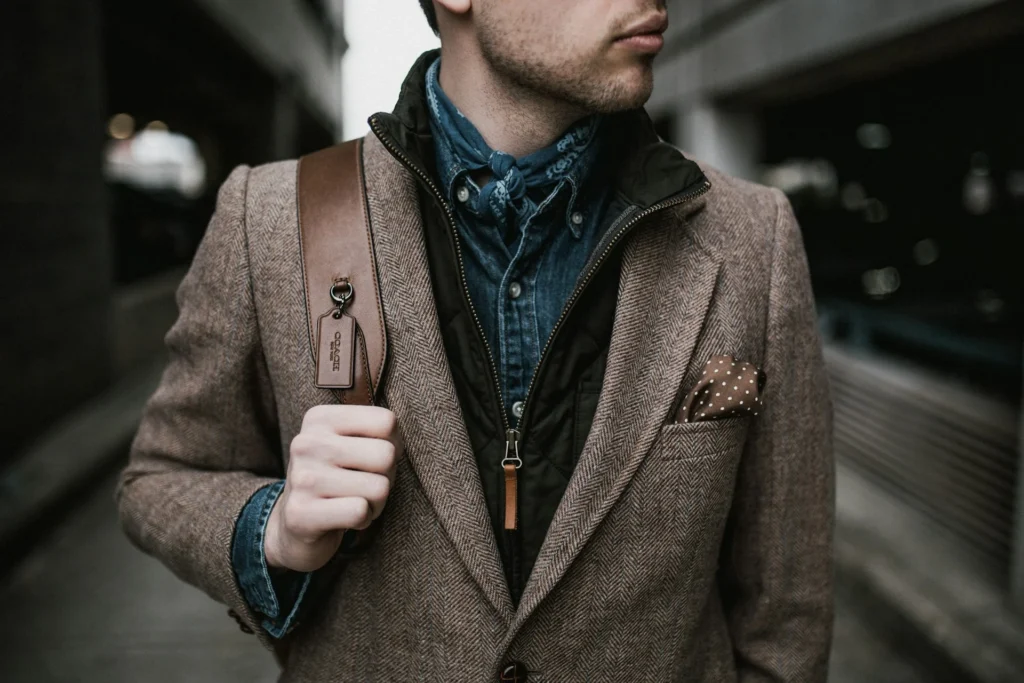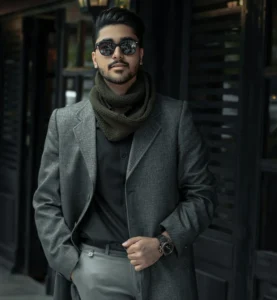The Art of Layering: Creating Versatile Outfits for Men
Picture this: It’s a crisp autumn morning, and you’re running late for work. You grab your go-to outfit, only to step outside and realize it’s too cold for just a shirt but too warm for your winter coat. Sound familiar? Or maybe you’ve found yourself caught in an unexpected downpour without a suitable jacket, or sweating through a surprisingly warm afternoon in your cozy sweater.
These everyday wardrobe dilemmas are all too common, but there’s a stylish solution that can prepare you for whatever the day throws your way: mastering the art of layering. Layering isn’t just a fashion trick; it’s a game-changer that can elevate your style, expand your wardrobe options, and prepare you for whatever the day throws your way.
In this comprehensive guide, we’ll explore the world of men’s layering, covering everything from the basics to advanced techniques. By the end, you’ll be equipped to create versatile, stylish outfits that work for any occasion.
Contents
Why Layering Matters
Before we jump into the how-to, let’s talk about why layering is such a crucial skill for modern man.

Versatility: Layering allows you to create multiple looks from a handful of pieces. It’s like having a wardrobe multiplier at your fingertips.
Practicality: Weather can be unpredictable, and your day might take you from a chilly morning commute to a warm office and back out into the evening chill. Layering lets you adapt to changing temperatures and settings with ease.
Style Expression: Each layer is an opportunity to showcase your personal style. It’s a way to add depth, texture, and visual interest to your outfit.
Cost-Effectiveness: By learning to layer effectively, you can create more outfits with fewer pieces, saving you money in the long run.
Comfort: Properly layered outfits allow you to regulate your body temperature more effectively, keeping you comfortable throughout the day.
The Basics: Your Layering Foundation
Think of layering like building a house. You start with the foundation and work your way up. In clothing terms, this means starting with the layer closest to your skin and building outward. Let’s break down the typical layers:
Base Layer
This is your foundation, the layer that sits directly against your skin. Its primary functions are moisture management and temperature regulation.
Key base layer pieces:
- T-shirts (crew neck and V-neck)
- Undershirts
- Lightweight long-sleeve shirts
- Thermal underwear (for cold weather)
Tips for base layers:
- Choose breathable fabrics like cotton, merino wool, or moisture-wicking synthetics.
- Fit should be close to the body but not restrictive.
- Neutral colors are versatile, but don’t be afraid to add a pop of color here if it works with your overall outfit.
Mid-Layer
This is where you start to add some personality to your outfit. Mid-layers provide insulation and are often the most visible part of your ensemble.
Key mid-layer pieces:
- Button-up shirts
- Sweaters (crew neck, V-neck, turtleneck)
- Cardigans
- Light jackets (denim, bomber)
- Vests
Tips for mid-layers:
- This layer offers the most variety in color, pattern, and texture.
- Fit should be comfortable but not baggy, allowing room for a base layer underneath and an outer layer on top.
- Consider the neckline of your mid-layer and how it will interact with your base layer.
Outer Layer
Your outer layer is your protection from the elements and often the statement piece of your outfit.
Key outer layer pieces:
- Coats (pea coats, trench coats, overcoats)
- Heavy jackets (leather, puffer)
- Blazers
- Parkas (for extreme cold)
Tips for outer layers:
- Choose versatile colors that pair well with multiple outfits.
- Consider the climate you live in when investing in outer layers.
- Fit should accommodate your other layers without looking bulky.
The Golden Rule of Layering
As you build your layers, remember this golden rule: thin to thick, light to heavy. This means starting with the lightest, thinnest layers closest to your body and gradually increasing in weight and thickness as you move outward.
This approach serves two purposes:
- It keeps you comfortable by trapping warm air close to your body.
- It creates a sleek silhouette, preventing you from looking bulky or overstuffed.
Color and Texture: The Secret Sauce of Stylish Layering
Now that we’ve covered the basic structure of layering, let’s dive into what really makes a layered outfit pop: the interplay of color and texture.
Color Coordination
Matching colors doesn’t mean wearing the same shade from head to toe. Instead, aim for a cohesive color palette that includes complementary or contrasting colors.

Color strategies for layering:
- Monochromatic: Use different shades of the same color family for a sleek, put-together look.
- Complementary: Choose colors that sit opposite each other on the color wheel for a bold contrast.
- Analogous: Select colors that are next to each other on the color wheel for a harmonious look.
A good rule of thumb is to keep your base layer simple and neutral, then add pops of color in your mid or outer layers. This allows you to create visual interest without overwhelming the eye.
Texture Mixing
Texture is often overlooked in men’s fashion, but it’s a powerful tool for adding depth and interest to your outfits. Mixing textures can elevate a simple layered look to something truly stylish.
Texture combinations to try:
- Smooth + Rough: Pair a sleek cotton shirt with a chunky knit sweater.
- Matte + Shiny: Combine a matte wool coat with a glossy leather jacket.
- Soft + Structured: Layer a soft cashmere sweater under a structured blazer.
When mixing textures, try to create contrast while ensuring the overall look remains balanced. Too many competing textures can make an outfit look busy or chaotic.
Seasonal Strategies for Layering
One of the best things about mastering layering is that it allows you to adapt your style to any season. Let’s break down some strategies for each time of year.
Spring Layering
Spring is all about lightweight layers that can be easily added or removed as the temperature fluctuates.
Key pieces for spring:
- Light cotton shirts
- Thin cardigans or sweaters
- Lightweight jackets (denim, bomber, or light rain jackets)
Spring layering tip: Embrace pastel colors and floral patterns to capture the essence of the season.
Summer Layering
Yes, you can layer in summer! The key is to choose breathable, lightweight fabrics.

Key pieces for summer:
- Linen or light cotton shirts
- Lightweight blazers
- Thin cotton sweaters for cool evenings
Summer layering tip: Use layering for sun protection. A light, long-sleeve shirt over a T-shirt can keep you cool and shielded from UV rays.
Fall Layering
Fall is the prime season for layering, offering endless possibilities for stylish combinations.
Key pieces for fall:
- Flannel shirts
- Light to medium-weight sweaters
- Leather or suede jackets
- Lightweight scarves
Fall layering tip: Embrace rich, warm colors like burgundy, mustard, and forest green to capture the autumnal mood.
Winter Layering
Winter layering is all about staying warm without sacrificing style.
Key pieces for winter:
- Thermal base layers
- Heavy knit sweaters
- Insulated jackets or coats
- Warm accessories (scarves, gloves, hats)
Winter layering tip: Don’t neglect your lower half. Thermal leggings under jeans can add warmth without bulk.
Occasion-Specific Layering
Different situations call for different approaches to layering. Here’s how to adapt your layering game for various occasions:
Casual Everyday Looks
For your day-to-day outfits, focus on comfort and versatility.
Example casual layered look:
- Base: Solid color T-shirt
- Mid: Open button-up shirt or light sweater
- Outer: Denim or bomber jacket
- Bottom: Well-fitted jeans or chinos
Casual layering tip: Don’t be afraid to leave your button-up shirt unbuttoned over a T-shirt for a relaxed vibe.
Office-Appropriate Layers
Professional settings require a more polished approach to layering.

Example office layered look:
- Base: Dress shirt
- Mid: V-neck sweater or vest
- Outer: Blazer or sport coat
- Bottom: Dress pants or khakis
Office layering tip: Ensure your layers are well-pressed and fit impeccably to maintain a professional appearance.
Late Night and Social Events
For social occasions, your layers can help you make a stylish statement.
Example Late night layered look:
- Base: Fitted T-shirt or henley
- Mid: Well-fitted button-up shirt
- Outer: Leather jacket or blazer
- Bottom: Dark wash jeans or dress pants
Social event layering tip: Choose one statement piece, like a bold jacket or patterned shirt, and keep the rest of your layers more subdued.
Outdoor Activities
For outdoor adventures, focus on performance fabrics and practical layers.
Example outdoor layered look:
- Base: Moisture-wicking long-sleeve shirt
- Mid: Fleece jacket or wool sweater
- Outer: Waterproof and breathable shell
- Bottom: Quick-dry pants or shorts
Outdoor layering tip: Look for pieces with zippered vents to help regulate your temperature during activities.
Common Layering Mistakes and How to Avoid Them
Even style-savvy men can fall into layering pitfalls. Here are some common mistakes and how to steer clear of them:
Overheating
The Problem: Piling on too many layers can leave you sweating and uncomfortable.
The Solution: Make sure each layer serves a purpose. If you find yourself constantly removing layers, you’ve likely overdone it.
Bulkiness
The Problem: Poor layering can make you look puffy or overweight.
The Solution: Keep your base layers slim-fitting and choose thinner, high-quality materials for insulation.
Clashing Patterns
The Problem: Combining too many patterns can create a chaotic, unfocused look.
The Solution: When in doubt, stick to one patterned piece per outfit. Let it be the star and keep other layers solid.
Inconsistent Formality
The Problem: Mixing very casual pieces with very formal ones can look disjointed.
The Solution: Aim for a consistent level of formality across your layers, or use contrasting formality intentionally for a specific style statement.
Neglecting Proportions
The Problem: Unbalanced proportions can make your outfit look awkward.
The Solution: Pay attention to the lengths of your layers. Generally, the outer layers should be longer than the inner layers.
Advanced Layering Techniques
Once you’ve mastered the basics, try these advanced moves to take your layering game to the next level:
Playing with Proportions
Experiment with the lengths of your layers. A longer undershirt peeking out from under a sweater can add visual interest. Or try a shorter jacket over a longer button-up for a modern look.
Unexpected Combinations
Break the rules (intentionally) by combining pieces in unconventional ways. Try a denim jacket under a blazer, or layer a hoodie under a leather jacket for a high-low mix.
Tonal Layering
Create a sophisticated look by layering different shades of the same color. This works particularly well with neutrals like gray, navy, or brown.
Accessorizing as Layering
Don’t forget that accessories can act as layers too. Scarves, vests, and even socks can add depth to your outfit.
Remember, Layering is an art, and like any art, it takes practice to master. But with the knowledge you’ve gained from this guide, you’re well on your way to becoming a layering virtuoso. Your days of standing frustrated in front of your closet are over—a world of stylish, versatile outfits awaits.